With flower bulbs you put your own little surprise in the garden. If buried deep in the ground, beautiful flowers will appear in the same spot months later.
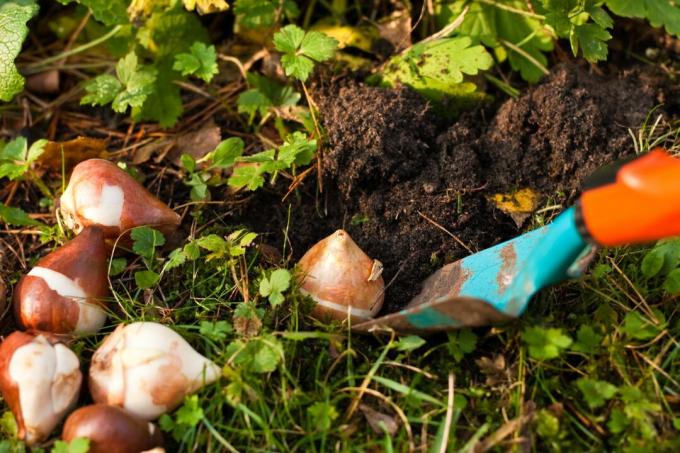
When buying, make sure that the flower bulbs are nice and firm and fresh. They should not be stored for long periods of time. Nevertheless, it is important to wait until the right time to plant the flower bulbs.
contents
-
Planting flower bulbs: when is the right time?
- Plant flower bulbs in spring
- Plant flower bulbs in summer
- Plant flower bulbs in autumn
-
The right location
- Plant baskets for flower bulbs
- Flower bulbs in a pot
- Overwinter bulbs
- Flower bulbs in a jar
-
Instructions for planting flower bulbs
- How do you plant flower bulbs?
- How deep should you plant flower bulbs?
- Lasagna planting with flower bulbs
Tip: There are many plants that survive the winter with the help of underground renewal buds. Such plants are called geophytes. There are rhizome, tuberous and bulbous geophytes, as well as those that form a root sucker. So not all plants that survive in the soil are bulbous plants. Crocus, dahlia, begonia, gladioli and cyclamen, for example, form tubers, and irises push their leaves out of rhizomes.
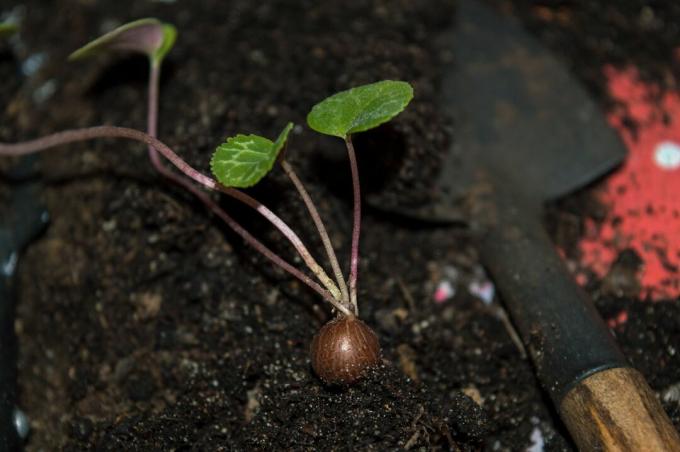
Planting flower bulbs: when is the right time?
Although autumn is considered the season for planting flower bulbs, there are also species that are planted in spring or even summer. When to plant flower bulbs depends, among other things, on the flowering period and the frost tolerance of the plant species.
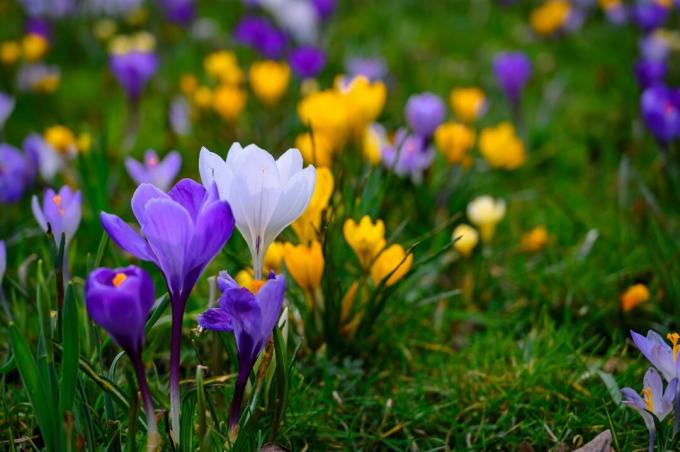
Plant flower bulbs in spring
Some plant species form bulbs whose flowers appear in summer. Such species are usually also sensitive to frost, which is why you should plant these flower bulbs in spring. You usually wait until no more severe frosts are to be expected, i.e. until the end of April or May. Examples of summer-blooming geophytes include:
- dahlias (dahlias)
- gladioli (Gladiolus-Hybrid)
- anemones (anemone), for example autumn anemones (Anemone hupehensis) or summer anemones (Anemone multifida)
- star gladiolus (Acidanthera bicolor)
- tuberous begonias (Begonia tuberhybrida-Group)
- Indian flower cane (canna indicagroup)
- lily of the valley (convalaria majalis), can be planted in both spring and autumn
- European cyclamen (Cyclamen purpurascens), to plant in spring or summer
- summer hyacinth (Galtonia candicans)
- lilies (Lilium), for example the gold ribbon lily (Lilium auratum), the Madonna lily (Lilium candidum) or the Turk's cap lily (Lilium martagon)

Lilies also flower in summer, but can be planted from March or in autumn due to their lower sensitivity to frost. Lilium henryi is even preferentially planted in the fall.
Plant flower bulbs in summer
Some geophytes do not flower in spring or summer, but in autumn. Depending on their heyday, they are planted later. The right time to plant the bulbs or tubers is in August and September. The flowers appear just six weeks after planting. Well-known autumn bloomers are for example:
- autumn crocus (Colchicum autumnale)
- Glorious autumn crocus (Crocus speciosus)
- European cyclamen (Cyclamen purpurascens), which can also be planted in spring

Plant flower bulbs in autumn
When it comes to flower bulbs, the early bloomers usually come to mind immediately. The bulbs are planted in autumn and the flowers will appear next spring. When planting, pay attention to the weather. If the autumn is particularly mild, it can happen that the plants sprout too early. Depending on the plant species, the bulbs are planted between September and November. Well-known early bloomers are for example:
- crocuses (Crocus), like the spring crocus (Crocus vernus)
- daffodils (Narcissus), like the yellow daffodil (Narcissus pseudonarcissus)
- snowdrop (Galanthus), like the Turkish snowdrop (Galanthus elwesii)
- squills (Scilla), like the two-petalled squill (Scilla bifolia)
- tulips (Tulipa)
-
leek (Allium), such as star bulbs (Allium christophii), allium (Allium moly) and
wild garlic (Alium ursinum) - anemone (anemone), like the wood anemone (Anemone nemorosa)
- prairie lilies (Camassia), such as Leichtlin's prairie lily (Camassia lightlinii)
- Ordinary Snow Pride (Chionodoxa luciliae)
- lily of the valley (Convallaria majalis)
- Spring Cyclamen (Cyclamen coum)
- winterling (Eranthis hyemalis)
- steppe candles (Eremurus), like the narrow-leaved steppe candle (Eremurus stenophyllus)
- chess flowers (Fritillaria), like the checkerboard flower (Fritillaria meleagris)
- Dog's Tooth Lily (Erythronium dens-canis)
- bluebells (Hyacinthoides), like the common bluebell (Hyacinthoides nonscripta)
- garden hyacinth (Hyacinthus orientalis)
- Single-flowered spring star (Ipheion uniflorum)
- knotted flowers (leucojum), like the March cup (Leucojum vernum)
- Henry's lily (Lilium henryi)
- Tufted grape hyacinth (Muscari comosum)
- milk stars (Ornithogalum), like the Great Milk Star (Ornithogalum sochi)
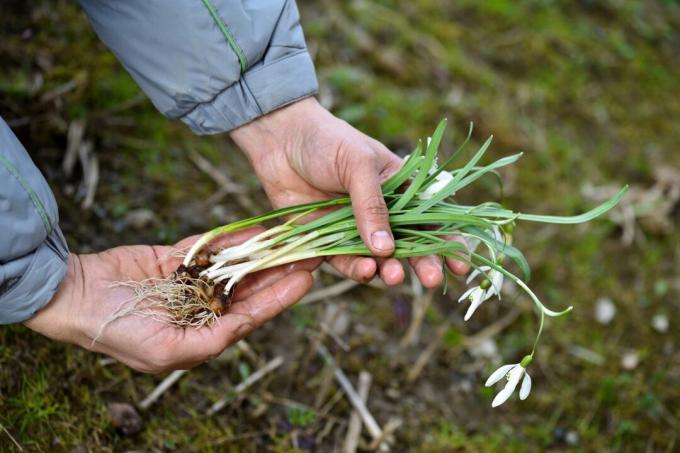
At a glance: When should you plant which flower bulbs?
- The exact planting time depends on the flowering time and frost sensitivity of the plant species.
- Summer flowering geophytes are usually planted in spring.
- Early bloomers are usually set in autumn.
- A few bulb plants are planted in summer.
The right location
The right location depends of course on the respective plant species. However, most early bloomers prefer a bright and sunny location. They sprout before the trees bear their leaves in order to take full advantage of the limited light available in spring. Exceptions are wild garlic, dog's tooth, bluebells, martagon lily and cyclamen. They need a shady to semi-shady place. In addition, most garden varieties prefer a nutrient-rich and water-permeable soil. The formation of waterlogging should be avoided at all costs so that the flower bulbs do not start to rot.
Plant baskets for flower bulbs
Because mice, especially voles, who like to grab the flower bulbs in the garden, are happy to use plant baskets to help. These special plant baskets for flower bulbs are buried with the bulbs in the ground and serve as a barrier for rodents burrowing underground. In addition, the bulbs are easier to get out of the ground again with the help of the plant basket in order to overwinter or oversummer.
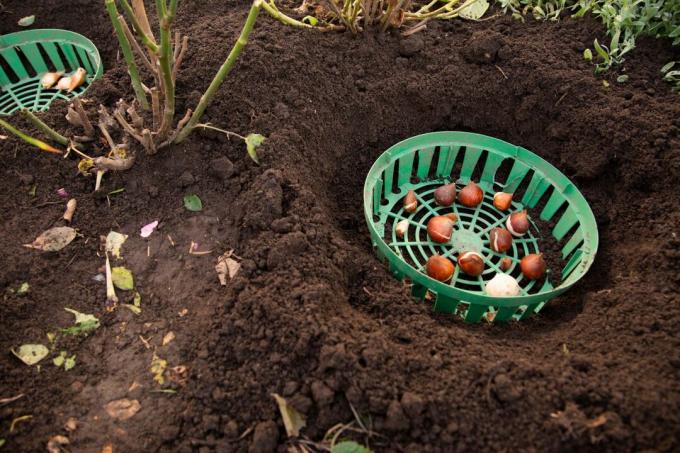
Flower bulbs in a pot
You can also plant flower bulbs in pots. The vessel should be sufficiently deep and have a drainage hole. In addition, the application of a drainage layer is recommended. A nutrient-rich and well-drained substrate, such as ours, should also be used in pots Plantura organic potting soil, be used. Our organic, peat-free soil remains structurally stable for a long time and is pre-fertilized with important nutrients for the plants. Thanks to the expanded clay it contains, it is water-permeable and does not tend to become waterlogged. After planting, place the container in a bright and sunny place in the garden or on the balcony.
tip: Planting tulip bulbs in pots is particularly worthwhile: they must have a warm and dry summer, which can easily be achieved in a plant pot with a very permeable substrate.
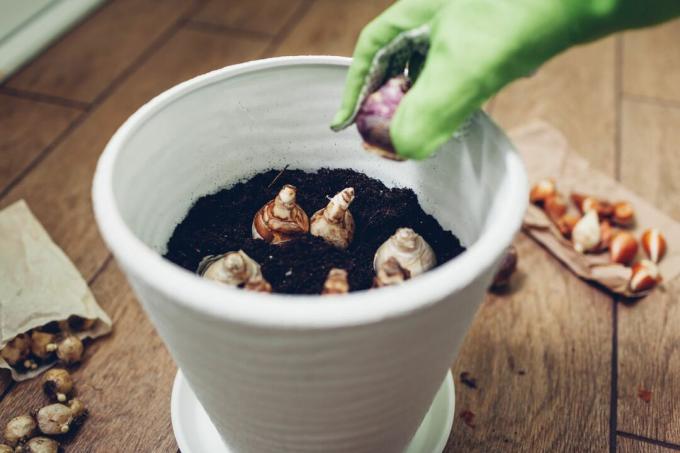
Overwinter bulbs
For overwintering the flower bulbs in pots, frost protection should be applied or a sheltered winter quarters should be used, as the soil in the pot freezes through easily.
For frost-sensitive plants such as tuber begonias, dahlias, gladioli and star gladioli, some types of ornamental onions (Allium aflatunense, Allium giganteum), canna and crown anemones and summer hyacinths, effective protection against frost is essential both in pots and when planted in the ground.
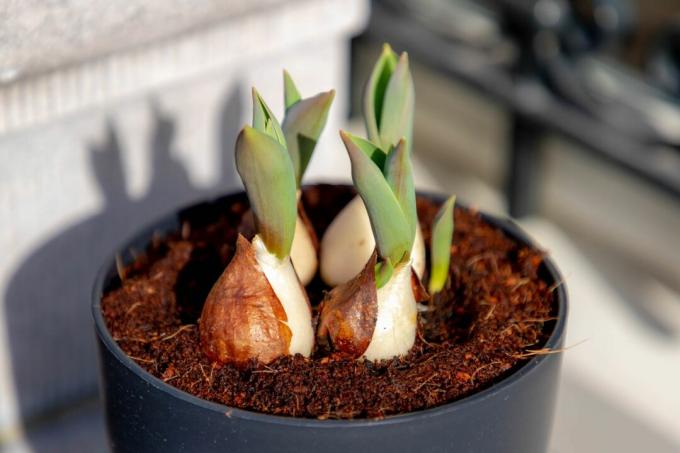
Flower bulbs in a jar
Flower bulbs can also serve as decorative heralds of spring in the warm room. Suitable bulbs are stored in cold stores as early as autumn to lure them into flowering earlier with this simulated winter. Alternatively, you can buy flower bulbs yourself in the fall, store them in a cold place - for example in a shed, well protected from mice of course - and bring them indoors in late winter or early spring. Now they are used for “forcing”: you bring them into the warmth and make them believe that it is time for sprouting. Driving hyacinths is just as possible as knight star (Hippeastrum) and tazzettes (Narcissus tarzetta).
Floating flower bulbs in a glass – instructions:
- Use prepared flower bulbs - they must have experienced a cold stimulus.
- Cover the glass with a net or use one with a waist.
- Fill the vessel with water - this should be sterile by boiling it.
- Leave a space of at least 1 cm between the onion and the water.
- Insert onion.
- Place in a bright and cool place at approx. 10 °C and put the cardboard cap on the onion to darken it until it is lifted by the shoot.
- Top up water regularly.
- When flower buds appear, the jar is placed in a warm place.
- The flowers will soon appear. Do not choose a location that is too warm or at least move to a cool room at night - this way the plant will last longer.
- After flowering, the bulb can be planted and cultivated further.
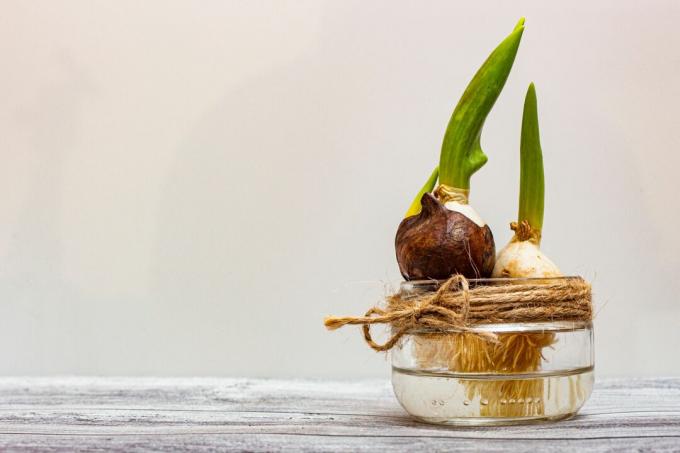
Instructions for planting flower bulbs
To plant flower bulbs, proceed as follows:
- Dig a planting hole: It should be so deep that the tip of the bulb is 1.5 times the height of the bulb deep in the ground. This information is a rough "rule of thumb": Exact information can usually be found on the packaging of the seedlings. If a drainage or substrate layer is filled in, the hole must be dug correspondingly deeper.
- In heavy and impermeable garden soils, fill in a drainage layer of sand or gravel to avoid waterlogging.
- Fill in substrate: Use a good quality substrate, such as our pre-fertilized, peat-free Plantura organic potting soil.
- Firmly bury the bulbs in the soil with the tips pointing up.
- Space the bulbs appropriately, as recommended for each type of plant.
- Plant bulbous plants in groups for a good effect.
- Cover with soil, press down and water.
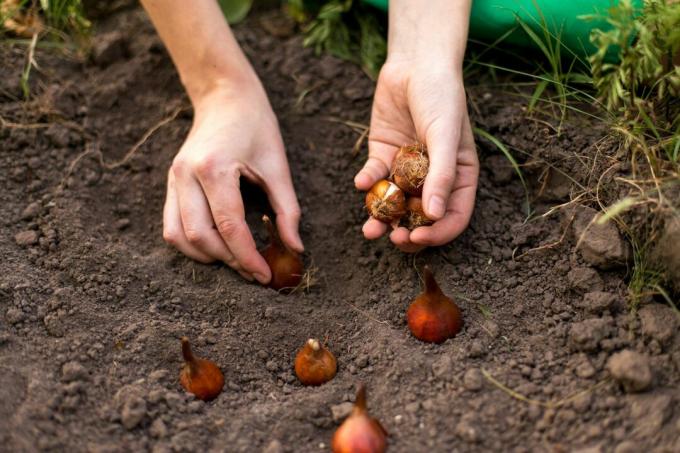
Can you still plant sprouted flower bulbs? Yes, you can still plant flower bulbs that have already sprouted. Flower bulbs that have been pushed out in the spring should not be brought outside until mid-May and planted in pots or soil. They can now use their green leaves to carry out photosynthesis and thus collect energy for the following year's budding. If you happen to have flower bulbs on hand that have sprouted too early in autumn, it is better not to plant them out: they are too sensitive to frost and would freeze to death. Overwinter these bulbs planted in fresh soil in a cool and bright place. In the spring they are allowed to go outside.
How do you plant flower bulbs?
Flower bulbs are placed in the ground with the tip, i.e. with the rather long side upwards. With some, rather flat onions, it is not so easy to identify the correct side. Sometimes you can already see a root approach that should be directed downwards. This spot is also called onion base, onion slice or onion cake. Some plants also make it to the surface if stuck in the ground upside down. They then grow upwards once around the bulb and just need a little more time until they break through the surface of the earth. However, it can also happen that their energy is not sufficient for the detour and the plant never reaches the surface - so place your flower bulbs in the right direction if possible.

How deep should you plant flower bulbs?
How deep you should plant flower bulbs depends on the size of the flower bulb. As a rule of thumb for depth, 1.5 times the height of the bulb is recommended. This means that as soon as the onion sits in the ground, 1.5 times the height of the onion is filled up again. The hole has to be dug a little deeper at the beginning.
Lasagna planting with flower bulbs
When planting lasagne with flower bulbs, also known as tiered planting, different flower bulbs with staggered flowering times are layered on top of each other in a planter. In this way, different bulb plants bloom over a longer period of time without having to be replanted. If you plant flower bulbs according to the lasagna principle, the plants that bloom first come to the top. Those that bloom last form the bottom layer. With enough space, you can achieve a continuous splendor of flowers over the entire vegetation period from February to September. Flower bulbs can of course also be planted in several layers in the bed.
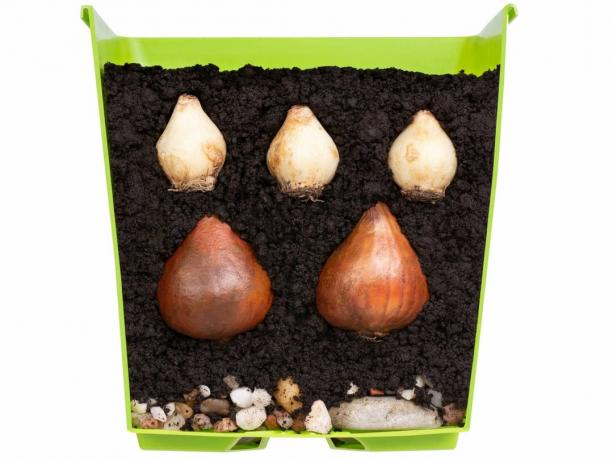
Tulips are one of the most well-known bulb plants and enrich the garden with their blossoms in spring. We show you how Tulips over summer should, so that they bloom again next year.
